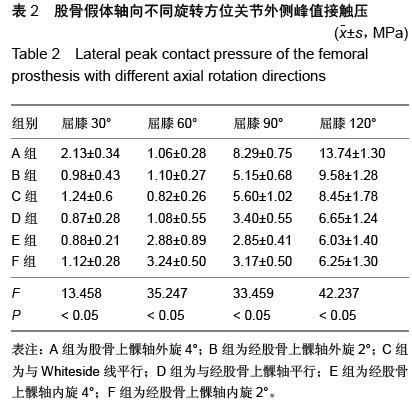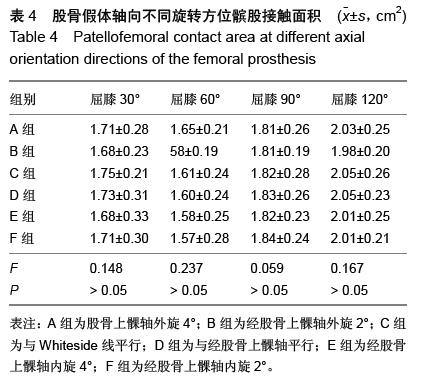| [1] 余存泰,覃健,侯之启,等.特定序列CT扫描检测全膝关节置换假体旋转稳定性[J].中国临床解剖学杂志,2007, 25(3):282-284.[2] 罗吉伟,余存泰,覃健,等.全膝关节置换术的假体旋转力线不良与髌股关节并发症[J].南方医科大学学报, 2006, 26(2): 217-219. [3] 陈坚锋,冯宗权.膝关节置换术中股骨旋转截骨的研究进展[J].中国矫形外科杂志,2008,16(18):1404-1406.[4] Ma HM, Lu YC, Kwok TG, et al. The effect of the design of the femoral component on the conformity of the patellofemoral joint in total knee replacement. J Bone Joint Surg Br. 2007;89(3):408-412.[5] Figgie HE 3rd, Goldberg VM, Figgie MP, et al. The effect of alignment of the implant on fractures of the patella after condylar total knee arthroplasty. J Bone Joint Surg Am. 1989;71(7):1031-1039.[6] 储小兵.人工全膝关节置换术股骨假体旋转对线的实验与临床研究[D].上海:第二军医大学,2006.[7] Chang CB, Seong SC, Kim TK. Evaluations of radiographic joint space--do they adequately predict cartilage conditions in the patellofemoral joint of the patients undergoing total knee arthroplasty for advanced knee osteoarthritis? Osteoarthritis Cartilage. 2008;16(10):1160-1166. [8] 覃承诃.全膝关节置换术中胫、股骨假体旋转力线的相关研究[D].广州:第一军医大学,2006.[9] 周一新.人工膝关节假体设计对全膝关节置换术后髌股关节功能的影响[J].中华骨科杂志,2006,26(9):646-648.[10] Kaper BP, Woolfrey M, Bourne RB. The effect of built-in external femoral rotation on patellofemoral tracking in the genesis II total knee arthroplasty. J Arthroplasty. 2000;15(8):964-969.[11] Argenson JN, Blanc G, Aubaniac JM, et al. Modern unicompartmental knee arthroplasty with cement: a concise follow-up, at a mean of twenty years, of a previous report. J Bone Joint Surg Am. 2013;95(10): 905-909. [12] Conditt MA, Noble PC, Allen B, et al. Surface damage of patellar components used in total knee arthroplasty. J Bone Joint Surg Am. 2005;87(6):1265-1271.[13] 储小兵,吴海山,徐长明,等.胫骨假体旋转对线技术对髌股关节生物力学影响的实验研究[J].中国矫形外科杂志, 2005,13(23):1795-1797,1805.[14] Miller MC, Zhang AX, Petrella AJ, et al. The effect of component placement on knee kinetics after arthroplasty with an unconstrained prosthesis. J Orthop Res. 2001;19(4):614-620.[15] Smith AJ, Wood DJ, Li MG. Total knee replacement with and without patellar resurfacing: a prospective, randomised trial using the profix total knee system. J Bone Joint Surg Br. 2008;90(1):43-49.[16] D'Lima DD, Chen PC, Kester MA, et al. Impact of patellofemoral design on patellofemoral forces and polyethylene stresses. J Bone Joint Surg Am. 2003; 85-A Suppl 4:85-93.[17] 李宝文.全膝人工关节置换涉及的生物力学变化[J].中国组织工程研究与临床康复,2008,12(17):3313-3316.[18] 林祥波.固定与旋转平台膝关节假体有限元、体外生物力学分析及临床应用研究[D].上海:第二军医大学, 2009.[19] 刘忠堂.全膝关节置换术后髌股关节生物力学及临床研究[D].上海:第二军医大学,2007.[20] Matsumoto T, Muratsu H, Tsumura N, et al. Joint gap kinematics in posterior-stabilized total knee arthroplasty measured by a new tensor with the navigation system. J Biomech Eng. 2006;128(6): 867-871.[21] 杨庆武,赵文玲.股骨假体旋转力线与TKA术后疼痛相关性分析[J].中国伤残医学,2014,22(2):302-303.[22] Song MH, Kim BH, Ahn SJ, et al. Does the appearance of the patellofemoral joint at surgery influence the clinical result in medial unicompartmental knee arthroplasty? Knee. 2013;20(6):457-460.[23] Han I, Chang CB, Lee S, et al. Correlation of the condition of the patellar articular cartilage and patellofemoral symptoms and function in osteoarthritic patients undergoing total knee arthroplasty. J Bone Joint Surg Br. 2005;87(8):1081-1084.[24] Miller MC, Berger RA, Petrella AJ, et al. Optimizing femoral component rotation in total knee arthroplasty. Clin Orthop Relat Res. 2001;(392):38-45.[25] Armstrong AD, Brien HJ, Dunning CE, et al. Patellar position after total knee arthroplasty: influence of femoral component malposition. J Arthroplasty. 2003; 18(4):458-465.[26] Rhoads DD, Noble PC, Reuben JD, et al. The effect of femoral component position on the kinematics of total knee arthroplasty. Clin Orthop Relat Res. 1993;(286): 122-129.[27] 赵宝辉,陈百成,邵德成,等.股骨远端旋转对线参考轴线与胫骨机械轴关系的研究[J].中华外科杂志,2008,46(14): 1085-1087. [28] 友斯伟.全膝关节置换术中股骨假体及胫骨假体可靠的水平面旋转对线的确定[D].上海:上海交通大学,2013.[29] Berger RA, Nedeff DD, Barden RM, et al. Unicompartmental knee arthroplasty. Clinical experience at 6- to 10-year followup. Clin Orthop Relat Res. 1999;(367):50-60.[30] Fuchs S, Skwara A, Rosenbaum D. Preliminary results after total knee arthroplasty without femoral trochlea: evaluation of clinical results, quality of life and gait function. Knee Surg Sports Traumatol Arthrosc. 2005; 13(8):664-669. [31] Fantozzi S, Catani F, Ensini A, et al. Femoral rollback of cruciate-retaining and posterior-stabilized total knee replacements: in vivo fluoroscopic analysis during activities of daily living. J Orthop Res. 2006;24(12): 2222-2229.[32] Tanzer M, McLean CA, Laxer E, et al. Effect of femoral component designs on the contact and tracking characteristics of the unresurfaced patella in total knee arthroplasty. Can J Surg. 2001;44(2):127-133.[33] 齐峥嵘.全膝关节置换术股骨假体旋转对线对髌骨轨迹影响的临床研究[D].北京:军医进修学院,2010.[34] Picard F, Gregori A, Dean F, et al. Computer-assisted dynamic total knee arthroplasty using Whiteside's line for alignment. Orthopedics. 2006;29(10 Suppl): S104-107.[35] Stoddard JE, Deehan DJ, Bull AM, et al. No difference in patellar tracking between symmetrical and asymmetrical femoral component designs in TKA. Knee Surg Sports Traumatol Arthrosc. 2014;22(3): 534-542.[36] Bindelglass DF, Dorr LD. Current concepts review: symmetry versus asymmetry in the design of total knee femoral components--an unresolved controversy. J Arthroplasty. 1998;13(8):939-944. [37] Heller MO, Matziolis G, König C, et al. Musculoskeletal biomechanics of the knee joint. Principles of preoperative planning for osteotomy and joint replacement. Orthopade. 2007;36(7):628-634.[38] Zhang Guo-dong, Yang C, Yang G, et al. Application and development of kinematical alighment during total knee arthroplasty. Zhongguo Gu Shang. 2015;28(12): 1162-1165. [39] Zihlmann MS, Stacoff A, Romero J, et al. Biomechanical background and clinical observations of rotational malalignment in TKA: literature review and consequences. Clin Biomech (Bristol, Avon). 2005; 20(7):661-668.[40] Ulrich SD, Mont MA, Bonutti PM, et al. Scientific evidence supporting computer-assisted surgery and minimally invasive surgery for total knee arthroplasty. Expert Rev Med Devices. 2007;4(4):497-505.[41] Cheng T, Zhang G, Zhang X. Imageless navigation system does not improve component rotational alignment in total knee arthroplasty. J Surg Res. 2011; 171(2):590-600.[42] 李新胜,姜建威,储小兵,等.股骨后髁角的影像学测量临床价值[J].南京医科大学学报(自然科学版),2006, 26(5): 371-372.[43] Leadbetter WB. Patellofemoral arthroplasty in the treatment of patellofemoral arthritis: rationale and outcomes in younger patients. Orthop Clin North Am. 2008;39(3):363-380, vii. [44] Delanois RE, McGrath MS, Ulrich SD, et al. Results of total knee replacement for isolated patellofemoral arthritis: when not to perform a patellofemoral arthroplasty. Orthop Clin North Am. 2008;39(3): 381-388, vii. [45] Cannon A, Stolley M, Wolf B, et al. Patellofemoral resurfacing arthroplasty: literature review and description of a novel technique. Iowa Orthop J. 2008;28:42-48. [46] Becher C, Renke A, Heyse TJ, et al. Patellofemoral arthroplasty--results of a nation-wide survey in Germany and review of the literature. Z Orthop Unfall. 2008;146(6):773-781.[47] Berend KR, Lombardi AV Jr, Adams JB. Obesity, young age, patellofemoral disease, and anterior knee pain: identifying the unicondylar arthroplasty patient in the United States. Orthopedics. 2007;30(5 Suppl):19-23.[48] 肖瑜.全膝关节置换术中胫骨假体旋转对线技术的新方法[D].天津:天津医科大学,2008.[49] 储小兵,吴海山,祝云利,等.全膝置换术中股骨假体旋转参照轴的影像学比较研究[J].解放军医学杂志,2006, 31(1): 69-70.[50] 姜侃,曲铁兵,钟广军,等.人工膝关节置换术中股骨远端旋转对线方法的研究与进展[J].中国矫形外科杂志,2013, 21(21):2181-2183. |
.jpg)

.jpg)

.jpg) 从河南中医学院第二附属医院(河南省中医院)标本室获得10个新鲜人尸体膝关节。其中男7例,女3例,死亡年龄20-60岁,平均45岁,其中左膝和右膝各5个。所有膝关节标本无关节畸形且稳定性良好,软骨保存完整,无髌股关节并发症,被动活动不受限制,且下肢力线正常。所有标本均置于-70 ℃冰箱里保存。
从河南中医学院第二附属医院(河南省中医院)标本室获得10个新鲜人尸体膝关节。其中男7例,女3例,死亡年龄20-60岁,平均45岁,其中左膝和右膝各5个。所有膝关节标本无关节畸形且稳定性良好,软骨保存完整,无髌股关节并发症,被动活动不受限制,且下肢力线正常。所有标本均置于-70 ℃冰箱里保存。.jpg)
.jpg)